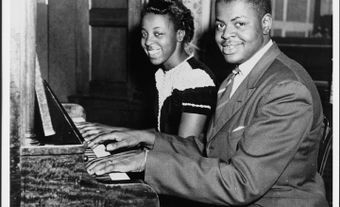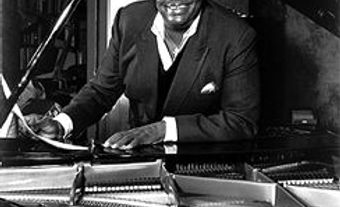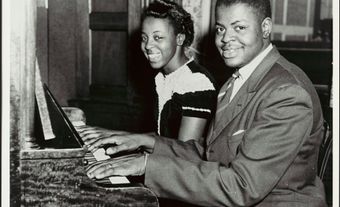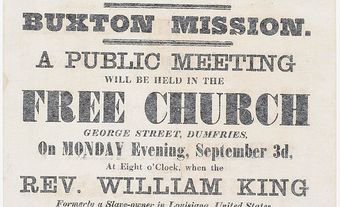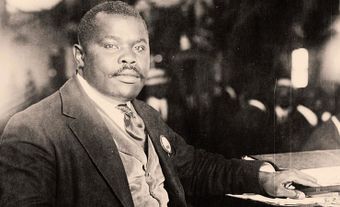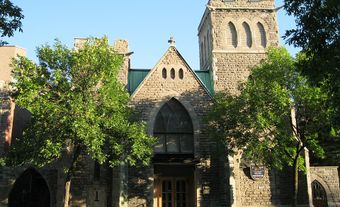Little Burgundy is a neighbourhood in the southwest borough of Montreal, Quebec. It is the historical home of the city’s Black English-speaking, working-class community (see also Black Canadians). Montreal's early Black settlement was comprised mainly of African Americans who lived in the Faubourg (French for "suburb") of St. Antoine — a neighbourhood that is now known as Little Burgundy. The settlement dates to the emergence of the railway companies in the mid- to late 19th century and the era of the Black sleeping car porters.
History
The Slavery Abolition Act, which came into effect in 1834, abolished slavery throughout the British Empire, including British North America (see also Confederation; Black Loyalists in British North America). The Act made enslavement officially illegal in every province (see Black Enslavement in Canada). In Montreal, Black people continued to hold low-paid and low-status positions such as cleaners, shoeshiners, domestic workers, busboys and water boys. A few prospered while running their own businesses, and tradesmen often found their skills in demand. Some Black people were also employed on the steamboats and in canal building. But the transportation of goods and people over water soon gave way to the lure of the railways (see Railway History).
The emergence of an English-speaking, working-class Black community in Little Burgundy is directly linked to the history of Canadian railways, specifically the Montréal & Lachine Railroad which later became the Grand Trunk Railroad and, eventually, the Canadian National Railway. While the railway industry generated enormous wealth for some people, much of its success relied on low-wage Black labour.

Black People in 19th-Century Montreal
As early as the 1820s, Black people freed by the Canadian Slavery Abolition Act worked alongside American fugitive slaves who had arrived via the Underground Railroad. Montreal was not the first choice of fugitives. Canada West (now Ontario) was perceived to be more hospitable to Black people than Canada East (now Quebec). However, anti-slavery groups on the eastern seabord still saw Montreal as a potential terminus or endpoint for runaway slaves who, when they arrived, ended up settling on the western margins of Old Montreal, close to Faubourg St. Antoine.
Sleeping Car Porters
In August 1870, the American Pullman Palace Company came to Montreal to manage sleeping and dining cars on Canadian railways.
Trained sleeping car porters, cooks and waiters were in demand. This brought Black Americans into Montreal, ushering in the era when the word “porter” became synonymous with Black men. Racially segregated from White workers in employment and status, Montreal's porters were a mobile group of young, strong temporary residents who generally stayed in the “quarters,” small, isolated boarding houses operated by the railroad companies that were located in Faubourg St. Antoine, along its east-west namesake artery: St. Antoine Street. They stayed in St. Antoine because the area was close to their jobs, and Black-run businesses that catered to them began to concentrate in this small area.
The porters endured the constraints of Montreal’s racially segregated housing market. Sub-standard housing was affordable, available and in close proximity to embarkation points for the Grand Trunk, the Bonaventure, Windsor Station (constructed in 1888-1889) and Central Station (constructed in 1938-1943). (See Railway Station.) This concentration of rail lines in St. Antoine attracted facilities and services that Black people were permitted to use. This was significant because businesses at that time could, and often did, refuse service to people on the basis of race (see Racial Segregation of Black People in Canada; Prejudice and Discrimination in Canada; Racism).
Wives, families and girlfriends eventually followed the men. Black people continued to establish themselves in St. Antoine, eventually moving westward in the city towards Mountain Street, and then Guy Street. Residential movement, however, was painstakingly slow. It would take decades to break the unwritten segregation barriers in St. Antoine’s housing market.
Community Building in St. Antoine in the Early 20th Century
The Coloured Women’s Club of Montreal
The Coloured Women’s Club (CWC) was established in St. Antoine in 1902 as a reaction to many mainstream White, Anglo-Saxon women's groups which excluded women of other races, religions and ethnicities. The African American members of the CWC attempted to provide moral leadership, and much-needed psychological and emotional support, in a city still reeling from a number of epidemics. Restrictions around racial, linguistic and ethnic affiliations created a patchwork of social services available to Black individuals and families. In response to the needs of their community, they fundraised for food, housing, clothing, blankets, and sometimes for burial plots and hospital beds. (See Anna Greenup.)
Union Congregational Church
In 1907, five years after the establishment of the Coloured Women’s Club of Montreal (CWC), the Union Congregational Church was also established in St. Antoine to meet the community’s needs. Prior to the 20th century, the religious face of Montreal's Black community was a patchwork of basement churches and gospel halls led by roving African American preachers. Many Black people experienced racism at mainstream churches of all denominations where the congregations were predominantly White. The Union Congregational Church de-emphasized denomination and stressed Black unity, community and acceptance.
The Coloured Women’s Club of Montreal and the Union Congregational Church stand out as two Black institutions that set the standards for community building and provided a model for navigating racial segregation and discrimination in mainstream society in the early 20th century. Together, these associations — located in an area bound by McGill College on the east and Peel on the west, Torrance Street to the north and Notre-Dame to the south — served upwards of 90 per cent of Montreal Black people.
St. Antoine and the Golden Era of Jazz in Montreal
For the next three decades, Montreal had three English-speaking Black communities: American, West Indian and Canadian. African Americans hovered between 40 per cent and 50 per cent of the Black population. The Black experience shaped the reputation, lifestyle and economic life of St. Antoine. Black culture defined the district in the 1920s, the golden period of Montreal’s Black history, bringing the city millions in taxes on alcohol alone. They opened famous nightclubs and ran gambling and prostitution rackets on St. Antoine Street that catered to the frequent White tourists looking for liquor, gambling and nightlife. Free from Prohibition, St. Antoine’s nightlife was a jazz mecca (see Rockhead’s Paradise). As a result, Montreal became one of three great jazz centres on the continent, alongside Chicago and New Orleans.
The Universal Negro Improvement Association (UNIA) and the Negro Community Centre (NCC)
West Indians came to Montreal from the Caribbean or the Maritimes. There was a significant amount of immigration from the West Indies during the First World War when these British subjects came to enlist and found that the Canadian Expeditionary Forces did not want them. Many decided to stay in St. Antoine.
In 1919, members of the West Indian community launched the Universal Negro Improvement Association (UNIA) in St. Antoine to offer a positive venue to express pride in Black racial heritage, history and culture. Though open to all, the UNIA was frequented by Black people who believed strongly in the economic and self-help policies espoused by Jamaican political activist and orator, Marcus Garvey.
Even though the railway companies were the major employer, West Indian entrepreneurs tried to create a strong Black economic base in St. Antoine. By 1928, West Indians, now comprising 40 per cent of Montreal’s Black population, were the most educated, vocal, rural and British of the three groups of Black people in Montreal. They found little in common with the previously established African American community.
In UNIA’s heyday, Black people attended Union Congregational Church Sunday mornings and social activities in the afternoons. These Sunday meetings focused on pan-Africanism which included lessons on the UNIA philosophy and discussion of international news stories about Black people . Concerts, dances and socials rounded out the offerings at UNIA’s Liberty Hall - its meeting place and activity center - each week.
In 1927, the Union United Church women established the Negro Community Association in St. Antoine to alleviate social, economic conditions and to promote racial advancement in greater Montreal. The Association would later be renamed the Negro Community Centre (NCC). It complemented the religious and social offerings of the church with social, recreational and educational activities. NCC founders believed that Black people needed to understand how to fit in and how to influence change from within. This meant partnering with the White mainstream, such as the Council of Social Agencies and the Financial Federation of Montréal.
The NCC made a difference particularly for the neediest and most marginalized, a group to which Canadian-born Black people tended to belong; their lack of education and poverty meant they occupied the lowest social place amongst St. Antoine’s Black people.
These three organizations — the NCC, the UNIA and the Union United Church— were interconnected and are the forerunners of all Black community organizations operating in English within Montreal, even today. St. Antoine was also the birthplace of the Free Lance (the first Black newspaper in Quebec), a credit union, and several fraternities, temperance and independent societies.
During the Great Depression, close to 80 per cent of Black people in St. Antoine were unemployed and out-migration to the United States began. Yet community members worked together to maintain a sense of belonging and connection, to offer support and build resilience through volunteerism and philanthropy. Black people kept their institutions alive and a rich cultural life of dramatic arts and music thrived. Community life moved westward from Mountain Street to St. Martin Street inching along toward Atwater Avenue.
By the Second World War, new work opportunities increased household incomes as young women left the domestic sphere and began engaging in factory and office work. Black people gained confidence and accelerated their campaign to change the country's anti-Black immigration policies (see Immigration Policy in Canada).
Canada’s Domestic Scheme (1955 - 1966) allowed West Indian women to obtain landed immigrant status and citizenship (see Domestic Service (Caregiving) in Canada). This resulted in the sponsorship of tens of thousands of people. These changes to immigration altered the character of the city. However, at the same time as Montreal experienced this massive influx of West Indians, Black people were being evicted in Little Burgundy.
From St. Antoine to Little Burgundy: A Community Scattered
Over the course of the 19th and 20th centuries, the Faubourgs of St. Joseph (to the south) and St. Antoine (to the north) were merged into a single neighbourhood and renamed Little Burgundy.
With tenements expropriated for massive urban renewal in St. Antoine, now renamed Little Burgundy, Black people moved west and south in the city. With Montreal’s Black urban landscape under renewal, Little Burgundy’s community organizations went into serious decline. The first major change was the expropriation of the Universal Negro Improvement Association (UNIA) which wound up on the periphery of Little Burgundy on Notre Dame Street.
In 1955, the Negro Community Centre (NCC) had just relocated to a new building and was also undergoing profound structural changes due to its administrative merger with the Iverley Community Centre, which catered to the White English-speaking population of St. Antoine. With this merger, 50 per cent of the NCC membership became White, though by 1962 that number had dropped to 35 per cent. By 1956, the NCC's mandate had become island wide. However, by the mid-1960s, the organization began to feel the harmful effects of urban renewal. The city controlled who could live there and vacant lots remained undeveloped for years. The number of Black people who could or wanted to return to Little Burgundy dwindled, as they were now comfortably settled elsewhere.
The loss of Black residents, and the lack of consistent outreach and organizational capacity led to a scattering of the community. Many local links were broken. In the 1970s, the NCC tried to address the dispersion by opening satellite storefronts in the neighbourhoods of Côte-des-Neiges, Lasalle and Notre-Dame-de-Grace (NDG). These satellite locations were coordinated through the Black Community Central Administration of Quebec (BCCAQ), headquartered in the NCC. The BCCAQ became the umbrella organization for a host of other initiatives such as the Black Youth Television Workshop, the Walker Credit Union and the Quebec Board of Black Educators.
Still, the demographic loss was staggering. By 1996 Little Burgundy, once home to 90 per cent of the city’s Black residents, was now home to only 2 per cent of all Black people in Montreal. Unable to renew its mandate, the NCC closed in 1989. Despite sporadic efforts to permanently reopen the NCC, its dilapidated structure was demolished in 2014.
The gap left by the decline and loss of the NCC led to the establishment of other Black organizations in Little Burgundy, such as Youth In Motion and the DESTA Black Youth Network. In 1987, Montreal police shot an unarmed 19-year-old Black man named Anthony Griffin. This act of violence was followed by other police shootings of Black males. This galvanized the Black community to take measures to create a safer environment for their youth. Black community leaders and the Little Burgundy community Borough Council ramped up efforts to reach out to area youth with updated green spaces and parks, brand new recreational and social facilities, and the Burgundy Urban Mediation Project (BUMP).
Little Burgundy Today
Today, Little Burgundy’s English-speaking Black residents live in a new community challenged by continuing gentrification as well as the impact of three generations of mandatory French schooling in Quebec (see Bill 101 (Charte de la langue française); Bill 101 Case). The city’s newer residents do not always have a geographical frame of reference for the Black community in the southwest. Many of Montreal’s Black residents are unaware of the history and legacy of the original community. However, thanks to Little Burgundy’s musical giants, Oscar Peterson, Oliver Jones, Charles Biddle and Daisy Sweeney, popular culture is replete with the enduring reminders of Montreal’s golden age of jazz and its connection to a historic and vibrant Black community.


 Share on Facebook
Share on Facebook Share on X
Share on X Share by Email
Share by Email Share on Google Classroom
Share on Google Classroom
